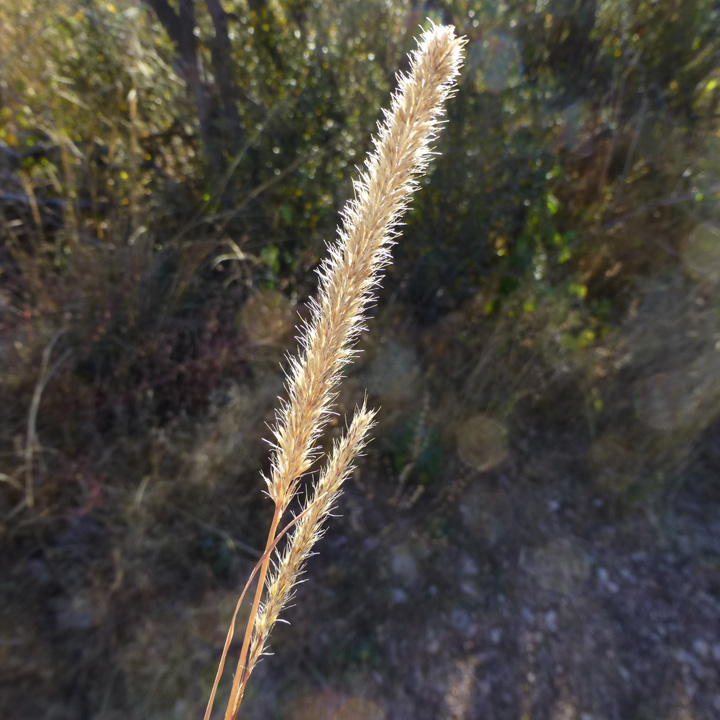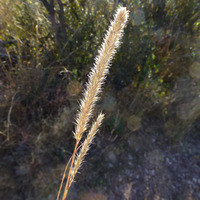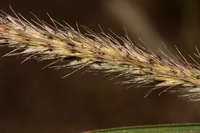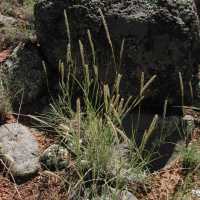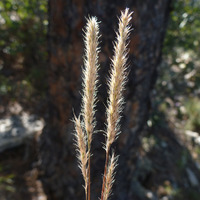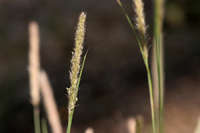Common Name: bristly wolfstail
Duration: Perennial
Nativity: Native
Lifeform: Graminoid
General: Densely caespitose perennial grass; stems 30-50 cm, erect with several nodes but sparingly branched, scabrous to puberulent at or near nodes.
Vegetative: Blades 4-9 cm long, 1-2 mm wide, glabrous, smooth or minutely roughened abaxially with whitish midribs and scabrous margins; midribs extend as fragile, easily broken, awnlike 4-7 mm apices; ligule 3-10 mm, hyaline, acuminate, sometimes shortly cleft on th
Inflorescence: Panicles 4-8 cm long, 7-8 mm wide; spikelets in unequally pediceled pairs, the short pedicels less than 1 mm, longer pedicels 1-2 mm; spikelets 3-4 mm; glumes 1-1.5 mm, scabrous apically; lower glume 2-veined and 2-awned with unequal minutely roughened awns, shorter awns 1-1.5 mm, longer 1.5-3 mm; upper glumes 1-veined, with single, flexuous 2.5-4 mm awn; lemmas 3-4 mm, tapering to a scabrous 1.5-3 mm awn; disarticulation at the fused base of the pedicels, the paired spikelets falling as a unit, leaving a cuplike tip.
Ecology: Found on rocky slopes and open mesas from 2,000- 10,000 ft (610-3048 m); flowers July-October.
Distribution: s CA east to OK; south to c MEX; disjunct in South America.
Notes: Distinguished by being an erect perennial bunchgrass to 50 cm tall, with leaves that are tipped with a small awn or bristle; and bristly spike-like inflorescences of single-flowered awned spikelets. Can be confused with Muhlenbergia wrightii which is similar, but that species grows at higher elevatations; has a first glume which is 1-veined and tipped with a very short awn; and has a lemma that is acuminate and unawned, or with a short awn no more than 1 mm long. Peterson and Columbus (2010) include this species in an expanded Muhlenbergia (as Muhlenbergia alopecuroides) to make that genus monophyletic . Some other sources, including the 2012 Flora Neomexicana, continue to use the name Lycurus setosus. The basic character to distinguish this species is bristles on the tips of the upper leaves. Felger et al. 2011 put all the former Lycurus into this species.
Ethnobotany: Unknown
Etymology: Muhlenbergia is named for Gotthilf Heinrich Ernst Muhlenberg (1753-1815) a clergyman and botanist from Pennsylvania; alopecuroides means like the genus Alopecurus.
Synonyms: Lycurus alopecuroides, L. phleoides var. glaucifolius, Lycurus setosus, Pleopogon setosum, P. setosus
Editor: SBuckley 2010, FSCoburn 2014, AHazelton 2015
Plants densely cespitose. Culms 30-50(60) cm, erect, with several nodes, sparingly branched, scabrous to puberulent at or near the nodes. Ligules (2)3-10(12) mm, hyaline, acuminate, sometimes shortly cleft on the sides (in dried specimens the fragile ligules may appear shorter because of the folded tip); blades 4-9(13) cm long, 1-2 mm wide, glabrous, smooth or scabridulous abaxially, scabridulous or hispidulous adaxially, with prominent whitish midribs and scabrous margins, midribs extending as fragile, easily broken, awnlike, (3)4-7(12) mm apices. Panicles 4-8(10) cm long, (5)7-8 mm wide; shorter pedicels 0.8-1(1.5) mm; longer pedicels 1-2 mm. Spikelets 3-4 mm. Glumes 1-1.5(2) mm, scabrous apically; lower glumes2-veined, with (1)2(3) unequal scabridulous awns, shorter awns 1-1.5 mm, longer awns (1)1.5-3(3.5) mm; upper glumes 1-veined, with a single, flexuous 2.5-4(5) mm awn; lemmas 3-4 mm, tapering to a scabrous 1.5-2(3) mm awn; anthers 1.5-2 mm, yellowish. Caryopses about 2 mm, brownish. 2n = 40.
Lycurus setosus grows on rocky slopes and open mesas, at elevations of 570-3400 m. Its range extends from the southwestern United States to northern Mexico, and, as a disjunct, in Argentina and Bolivia. It was found as an adventive (associated with wool waste) in North Berwick, York County, Maine, in 1902, but it has not been reported from there since. Its flowering time is July-October.
Lycurus setosus is sometimes confused with Muhlenbergia wrightii, which has a somewhat similar aspect but is normally found in moist habitats. Also, in M. wrightii the first glume is 1-veined with a very short awn, and the lemma is acuminate and unawned or with an awn no more than 1 mm long. Peterson and Columbus state that this species should be transferred to Muhlenbergia as M. alopecuroides but do not explicitly address the position of the other two species of Lycurus. It is retained in Lycurus until the appropriate treatment of the whole genus has been discussed.
Perennials, Terrestrial, not aquatic, Stems nodes swollen or brittle, Stems erect or ascending, Stems caespitose, tufted, or clustered, Stems terete, round in cross section, or polygonal, Stem nodes bearded or hairy, Stem internodes hollow, Stems with inflorescence less than 1 m tall, Stems, culms, or scapes exceeding basal leaves, Leaves mostly basal, below middle of stem, Leaves mostly cauline, Leaves conspicuously 2-ranked, distichous, Leaves sheathing at base, Leaf sheath mostly open, or loose, Leaf sheath smooth, glabrous, Leaf sheath or blade keeled, Leaf blades linear, Leaf blades very narrow or filiform, less than 2 mm wide, Leaf blade margins folded, involute, or conduplicate, Leaf blade with prominently raised or widened midvein, Leaf blades mostly glabrous, Leaf blades scabrous, roughened, or wrinkled, Ligule present, Ligule an unfringed eciliate membrane, Ligule elongated, 1-3 cm, Inflorescence terminal, Inflorescence a den se slender spike-like panicle or raceme, branches contracted, Inflorescence solitary, with 1 spike, fascicle, glomerule, head, or cluster per stem or culm, Inflorescence single raceme, fascicle or spike, Flowers bisexual, Spikelets pedicellate, Spikelets laterally compressed, Spikelet less than 3 mm wide, Spikelets with 1 fertile floret, Spikelets paired at rachis nodes, Spikelets all alike and fertille, Spikelets bisexual, Inflorescence disarticulating between nodes or joints of rachis, rachis fragmenting, Spikelets disarticulating below the glumes, Spikelets falling with parts of disarticulating rachis or pedicel, Rachilla or pedicel glabrous, Glumes present, empty bracts, Glumes 2 clearly present, Glumes equal or subequal, Glumes shorter than adjacent lemma, Glumes awned, awn 1-5 mm or longer, Glumes 1 nerved, Lemma 3 nerved, Lemma body or surface hairy, Lemma apex acute or acuminate, Lemma mucronate, very shortly beaked or awned, less than 1-2 mm, Lemma distinctly awned , more than 2-3 mm, Lemma with 1 awn, Lemma awn less than 1 cm long, Lemma awned from tip, Lemma margins thin, lying flat, Lemma straight, Lemma surface pilose, setose or bristly, Palea present, well developed, Palea membranous, hyaline, Palea about equal to lemma, Palea 2 nerved or 2 keeled, Stamens 3, Styles 2-fid, deeply 2-branched, Stigmas 2, Fruit - caryopsis, Caryopsis ellipsoid, longitudinally grooved, hilum long-linear.


